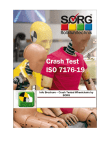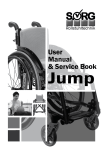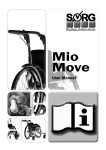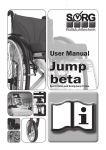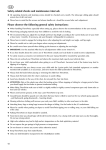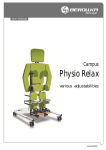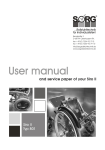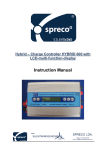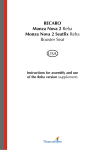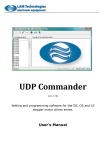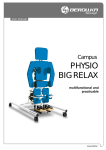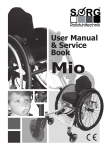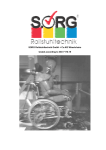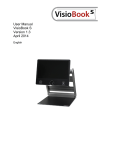Download Bedienungsanleitung englisch Tilty
Transcript
User manual of Tilty page 2 of 43 We are a company-member of rehaKIND e.V. International Support Group for the Rehabilitation of Children and Young People Editor: Bernhard Wendel Technical collaborator: Bernd Rothardt As at March 13 Technical alterations and misprints excepted. SORG Rollstuhltechnik GmbH + Co.KG Benzstraße 3 D-68794 Oberhausen-Rheinhausen Fon +49 7254 - 9279.0 Fax +49 7254 - 9279.10 [email protected] www.sorgrollstuhltechnik.de © All texts and pictures are subject to copyright and may not be published - not even as an excerpt! - without the explicit authorization of SORG Rollstuhltechnik GmbH + Co.KG © translated by: www.my-translator.biz User manual of Tilty page 3 of 43 1. Contents 1. 2. 3. Contents Preface General advice 3.1 Functional purpose 3.2 Features of Tilty 3 7 8 8 8 4. Safety precautions 9 5. Handling 5.1. Completion of use condition 5.2. Unfolding the chair 5.3. Folding up the chair 5.4. Loading and transport 5.5. Getting in and out the chair 5.6. Transporting the wheelchair 5.7. Rolling off 5.8. Carrying 13 13 13 14 15 15 16 16 16 6. Brakes 6.1. Standard knee lever brakes 6.2. Knee lever brakes - braked lockable 6.3. Knee lever brakes - braked and unbraked lockable 17 6.4. Brake lever lengthening 17 Safety precautions and advice for your orthopaedic mechanic engineer 6.5. Drum brakes Advice for your orthopaedic mechanic engineer Adjustment of wheel postions 21 7.1. Punch plate and camber 7.2. Alteration of the centre of gravity’s position 22 7.3. Adjustment of seat-tilting 22 7.4. Critical height of obstacle 7.5. Static stability Safety precautions and advice for your orthopaedic mechanic engineer 7.6. Adjustment of front wheel Advice for your orthopaedic mechanic engineer 7.7. Supporting wheel (overturning protection) 24 Advice for your orthopaedic mechanic engineer 17 17 17 18 19 19 7. 21 22 22 22 23 23 24 User manual of Tilty page 4 of 43 8. Wheels 8.1. Driving wheels 8.2. Grip rings 8.3. Spoke cover 8.4. Wheel cover 25 25 25 26 26 9. Seatback 9.1. Backrest 9.2. Seatback cover cloth standard 9.3. Seatback cover cloth restretchable 9.4. Fixed seatback 9.5. Lateral truss pads 9.6. Seatback inclination with notch system 9.7. Headrests 9.8. Stabilizing rod 27 27 27 27 27 28 28 28 28 10. Sliding handles 10.1. Extendable sliding handles / One-handed sliding handle 10.2. Sliding handles with sliding pole Safety precautions 11. Seat 11.1. 11.2. 11.3. 11.4. Fixed seatFix Seat extension Bolting device Seat cover cloth 12. Side parts 12.1. Side parts 12.2. Arm pads 29 29 29 29 31 31 31 31 32 33 33 33 User manual of Tilty 13. Leg supports Advice for your orthopaedic mechanic engineer 14. Further options 14.1. Therapy table 14.2. Safety belt 14.3. Tilt clip 14.4. Extension parts of other concerns page 5 of 43 36 36 37 37 37 37 39 15. Cleaning and maintenance 16. Warranty statement 16.1. Quality assurance system 16.2. Design life 16.3. Working life 16.4. Complaints 16.5. Data plate 41 43 43 43 43 44 44 17. Warranty clauses 18. Compliance statement 19. Warranty of delivery 19.1. Assemblage and inspection 19.2. User-chronology 19.3. Handing over Please make sure that the concerning items are filled out 20. List of maintenance 21. List of repair works 45 47 48 48 48 48 49 51 User manual of Tilty page 6 of 43 2. Preface Dear Customer, today, your child has met its new “daily companion” for the first time. A companion that would never let your child down and that will accompany him/her through thick and thin. Day after day, month after month, year after year. The most important precondition for such a cheerful and safe companionship is a sensitive reaction against all individual needs. We want to be such a reliable companion to your child. Therefore, we use our years of experience and we take a lot of care over development and assemblage. This is the only way for us to guarantee the permanent best quality, individuality and safety. After having been certified according to DIN EN ISO 9001:2000, we are under the obligation to continue this standard of quality perpetually. With a measurable result! Special people need special solutions. This is why we are developing mobilization solutions, all being as unique as their user. Therefore it may happen that some descriptions slightly differ from your child’s wheelchair because we’re on the road of permanent development and this individual variant may be not yet included in this user manual. Our specialist staff or your intermediary medical service centre will be pleased to answer all your questions about the handling. Please keep this service paper in a safe place and have filled out the required data on page 44. It will be proof of regular inspections, which might be decisive in case of a warranty claim. Moreover, it will be an important source of information for the costbearer in the event of the wheelchair’s further use. For a reliable use of the new wheelchair, please read the following sections carefully and pay attention to our advice and instructions for your child’s safety! More questions? Please consult our proficient staff, they’ll be pleased to help you! Service phone +49 07254 / 9279-0 Hugo Sorg, Managing director User manual of Tilty page 7 of 43 3. General advice This user manual has been drawn up not only for you but also for your orthopaedic mechanic engineer of the medical service centre – specialists who are able to adjust the wheelchair exactly to your individual needs and who will complete the wheelchair’s use-state. Therefore, this user manual includes instructions which you may in no circumstances carry out yourself – improper action will always be a risk to you, the user and your environment. Please take some time to read this user manual carefully and keep it in a safe place. 3.1 Purpose Our wheelchairs and seat pan undercarriages only serve people with impaired ability or disability as well as mentally handicapped for an individual use to be handled by yourself or others. Any other purpose is no appropriate use. 3.2 Features of Tilty Tilty’s main feature is the feasibility of tilting the seat-back-unity by 30°, meaning that the seat’s angle inclination may be adapted. In the same way and at the same time, Tilty’s backrest angle is adaptable by 40°, i.e. the back may be folded forwards for transport. As a result of Tilty’s design, the seat angle may be adapted (tilt-position) without really changing the centre of gravity, because the complete seat-back-unity will slide forwards a bit as it is tilted. Yet, these therapeutical advantages of Tilty unfortunately involve some risks for the user’s safety. You will have to get to know them in order to control them. This user manual will teach you all about the risks and will be your helpmate for a safe wheeling in the therapeutical daily life. These are the three main precautions you have to take: • NEVER activate the tilting-mechanism while wheeling the wheelchair! • NEVER wheel your Tilty in the tilted position or with stretched seatback WITHOUT tilting guard (safety or supporting wheel)! • NEVER wheel your Tilty as both seatback inclination and tilt-position are in their maximum position! A great number of safety aspects will be repeated again and again. Yet, if you carefully read this user manual, you will comprehend our reasons – we want you and your child to feel absolutely safe in the new Tilty. User manual of Tilty page 8 of 43 4. Safety precautions When developing and manufacturing our wheelchairs, we set great store by safety. In order to maintain this high quality of safety in everyday life, it is in your own and your child’s interest to carefully pay attention to the following rules. Improper use could cause a hazardous situation to you and your child and our assurance of warranty would no longer be valid. The following proceedings, eg. for familiarizing your child with the new wheelchair, are also valid in the modified form for adult users. But for the sake of simplicity, we will describe the following situations from a (very) young user’s point of view. Familiarizing with Tilty • Take your time to familiarize yourself and your child with the new situation. Be very patient and use caution to make sure that your child will feel safe in its new wheelchair. Because Tilty is an activity-wheelchair whose limits you’ll have to get to know. You should really let your child undergo these limits quite literally. Make sure that during the following steps both of you are safeguarded by an experienced and strong assistant! • Lock the parking brakes and put your child into the untilted Tilty. • Carefully practise the wheelchair’s behaviour on shifting the centre of gravity in all 4 directions! Make your child reach for objects, holding them further and further. • Sensitize your child for these changed situations and ask if something changes, and what exactly. And do not forget to express clearly that you will now intensify the situation. • In any case, this must all be practised without fear. Do not force the learning process! • Only after your child has been familiarized with the wheelchair’s static stability in its standstill position, you should risk trying out the wheeling behaviour. • Children soon understand how to drive a wheelchair, it nearly is an automaticity. The process of braking down however, needs thorough practice because it is dangerous! Tell your child in clear terms that the knee lever brake is NOT designed for braking down the wheelchair’s speed and that it may fall out of the chair. • Your child must learn that it should only use the grip rings for braking down the wheelchair. Set Tilty in a slow motion and make the child brake down the wheelchair to the standstill position with its palm on the grip rings. In doing so, the child should keep in mind what will happen as it reaches between tyre and grip ring (as far as the wheelchair is not equipped with our Rehavolution-wheels). If your child has got delicate hands, please give it some gloves, eg. for cycling, meaning with a leather inside – in no case mitts nor woolen gloves! User manual of Tilty page 9 of 43 (Never forget that strong friction will heat up the grip rings. Therefore, either wear some gloves or use the grip ring coating. Your medical assistant will be pleased to give you some advice.) • • • As your child has thoroughly been familiarized with the items „centre of gravity“ and „brakes“, you may carefully begin with the next items. At first, repeat the above exercises in the open country on even territory and only after that on gradients and slopes and always with another assistant. It is most important to create a situation your child is not afraid of. But: do never “play” dangerous situations, eg. by tilting the chair and then catching it meaning it to be a joke… Only real-life dangers may be engineered by your child. Further safety precautions • The danger of overturning will be considerably increased as Tilty’s seat angle and/or back angle is adjusted! • Therefore, never activate the tilting mechanism while wheeling the chair, but first of all get Tilty in the absolute safe standstill position with its parking brake and, if equipped with, its drum brake. • Before each seat-tilting or each backrest adjustment, make sure that the tilt guard (supporting wheel) is in the active mode and really leave it activated! • Examine the braking efficiency of the parking brake (knee lever brake) each time your child wheels off. Only when the driving wheels show adequate air pressure, the brake will work perfectly. For this purpose, try to slide Tilty with locked parking brakes – in their locked state, the wheels may only skid across the floor. • Please also keep in mind that wet or dirty tyres may considerably reduce the braking efficiency. Never change the parking brakes’ adjustment on your own authority because a wrong distance between brake unit and tyre may eliminate the braking efficiency completely. In this case, please consult your intermediary medical service centre immediately and have a qualified orthopaedic mechanic taken care of the problem. • The parking brake (knee lever brake) is designed for blocking the wheels and not for braking down the wheeling chair. Such improper use could cause a serious hazardous situation to your child and its environment! • Each time your child wheels off, you will have to check if the driving wheels’ plug-in axles have been thoroughly tightened. • Your child may never use the foot rest(s) or leg supports for getting in or out the wheelchair. The chair may turn over forwards. • Lock the parking brake each time your child gets in or out the wheelchair. • If possible, always use the supporting wheel. Especially when wheeling on gradients or slopes, on uneven territory or thresholds, the danger of turning over is really high. • When wheeling in public traffic, keep in mind that you must act according to User manual of Tilty • • • • • • • • • page 10 of 43 Road Traffic Act. In order to avoid accidents, you should always control if the reflectors are tidy and both of you should wear bright colours to be well seen. The wheelchair may not be carried together with its occupant but may only be wheeled. When transporting the wheelchair in a vehicle, your child may only sit in the chair as the chair is fixed onto the required devices. (see handling – transporting the wheelchair p.16). Have the wheelchair serviced regularly by a qualified medical service centre. It is necessary to examine if all screws are properly tightened, if welded joints show any damage and if signs of wear can be detected. Your child should get over steps and stairs only with an assistant. Take care that the supporting wheel is swung in and that the assistant(s) always uses the fixedly screwed metal parts of the wheelchair for carrying, because the sliding handles’ rubber caps may unexpectedly come off and cause serious accidents! In order to avoid injuries, your child should not take its hand between the driving wheels and knee lever brake or wheel cover. Do not wheel on gradients over 4°; meaning ca. 7%. The danger of overturning increases on gradients over 4°. An occupied wheelchair should never be left unsupervised on a slope, not even with locked knee lever brake. With an active (swung out) supporting wheel, the max. critical obstacle height is ca. 3cm. The max. useful vehicle load capacity is 90 kg. The standard frame is not equipped for more weight. User manual of Tilty page 11 of 43 5. Handling 5.1 Completion of use condition The wheelchair will be in working order for everyday life after having examined the following basic items: • have the cross braces been thoroughly snapped in the trestles? • is SeatFix thoroughly locked onto the cross braces, or rather • is the seat cover cloth in a perfect condition? • is the back cover cloth in a perfect condition, or rather • is the fixed seatback thoroughly locked into the securing devices at the back tube? • are the plug-in axles thoroughly snapped in the adapters? • are the steering wheels in working order and may they be easily rotated? • do the parking brakes show functional performance? • do the driving wheels show adequate air pressure? • is the supporting wheel in working order? • is the seat-tilting in perfect working condition? • is the gas pressure spring in working order? • is the Bowden wire on the release lever for tilting firmly in its suspension? 5.2 Tilting the seat-back-unity • For tilting backwards Tilty’s complete seat-back-unity in its angle by up to 30°, first of all lock the parking brake. • Now pull the release lever at the sliding handle or at the sliding clamp, keep it pulled out and slightly push the seat simultaneously for- and downwards. • Please keep in mind that the gas pressure spring will counteract your pressure – so, it will be hardly possible for you to tilt an empty chair. This is no failure, it rather is an indication of the gas pressure sping’s operativeness. • An easy-working gas pressure spring on an empty wheelchair is a definite sign that it no longer meets the requirements of the occupied wheelchair and must immediately be replaced. A faulty gas pressure spring is a considerable safety risk when tilting the chair because the seat, together with its occupant may suddenly bump down. • For getting the seat in its horizontal position again, re-lock the parking brake. • Once again, pull the release lever and slightly pull up the seat-back-unity until the needed position has been reached. User manual of Tilty page 12 of 43 5.3 Angle-adjustment of seatback • For adjusting the seatback in its angle, pull the string’s hook on Tilty’s backside until both attaching bolts in the notch joint have been unlocked. • Now, with a pulled out hook, get the seatback in the required position and get the attaching bolts snap into the notches. • Please take care that both bolts are really firmly engaged, otherwise the seatback may suddenly tilt back which would be, of course, very dangerous. • In order to undo the angle-adjustment, proceed in the analogous way. • Folding forwards the seatback for transport: first of all, get the extendable sliding handles or sliding clamp, if equipped with, in the lowest position. Then pull the string’s hook (instructions above) which will unlock the attaching bolts, keep the string pulled out and then fold the seatback forwards. If necessary, loosen the star screws on the sliding clamp and fold the clamp forwards. By removing the cushions and the fixed seatback, if equipped with, the back may be folded forwards by some more centimetres. 5.4 Getting in the chair Before you get into the chair, examine if the following items have been carried out properly: • First of all, the driving wheels must be assembled. For this, take hold of the driving wheel at its hub or spokes, press then with your thumb the locking button in the plug-in axle’s mid and now insert the axle in its fitment bush. Please make sure that the knee lever brakes have been released. • Take care that, with a non-pressed button, the hub is firmly inserted into the plug-in axle’s fitment bush. • Now lock the parking brake. • Afterwards and if necessary, get Tilty in the upright seating position. For this, use the tilting mechanism’s release lever on the sliding handle and at the same time, pull up the seat-unity on the sliding handles – back into the perpendicular position. • Get the seatback in its upright position as well. Firmly pull down the string’s hook on the seat’s backside until both bolts are released from the User manual of Tilty • • • • • • • • page 13 of 43 punch plate. Keep the hook pulled out and get the seatback into position. Then let go the string’s hook and make sure that the attaching bolts are really firmly engaged into the notch joint. Now fold back the leg support. If Tilty is equipped with height-adjustable leg support/s, first of all swing them downwards (notch joint). For this, pull the bolt out of the notch joint, get the leg support/s in the perpendicular position and re-lock them. Make sure that the screws on the seat’s underside are tightened properly, so nobody will be injured. If your Tilty is equipped with a fixed seatback, it will be assembled in the end. For this, slide downwards the seatback along the back tubes with open attaching bolts. Then close the bolts by simply turning them until they snap into the securing device. If necessary, fold outwards the lateral truss pads and push backwards the headrest. Now you/ your child may take your seat. But please take care that you, or your child, will not put weight on the foot rest/s, nor on the brake lever or brake lever lengthening. As an option, Tilty will be equipped with extendable sliding handles which you can get into the correct position simply by loosening the clamping levers. Afterwards, re-tighten the clamping levers. An extendable sliding clamp will be adjusted in height in exactly the same way. Then loosen the star grips and adjust the sliding clamp’s angle according to your needs - fix this position by re-tightening the star screws. Don’t worry, our star grips are made of tempered steel! So it will be quite impossible for you to plane down the star grip’s cogs. The one-handed sliding handle will be adjusted just like the other sliding handles. User manual of Tilty page 14 of 43 5.5 Getting out For getting out of the wheelchair, proceed in the analogous way: • Lock the parking brakes, so the wheelchair will not suddenly wheel off. • If necessary, fold back the leg support so your child will not be able to put its weight on it, meaning that the chair could wheel off and/or could turn over forwards, hurting you or your child. 5.6 Loading and transport The wheelchair can be made as small as possible by folding it forwards according to the following instructions: • First of all, remove all the cushions so the seatback may be folded forwards much easier. • If the wheelchair is equipped with extendable sliding handles, you will first of all have to push them down as far as possible and then secure them in this position. The same for a sliding clamp, afterwards turn backwards the clamp and re-tighten it. • Now fold forwards the seatback as described in 5.3 (p. 16). • Finally, the driving wheels may be removed. Unlock the parking brakes and press the small button on the plug-in axle’s mid. Then pull out the wheel with pressed button. Please always keep in mind that the plug-in axles are very delicate. So, take care that they are not dirty or damaged! Otherwise the wheelchair’s safety will no longer be ensured. • If your Tilty is equipped with drum brakes, the brake shoes will be unprotected after having removed the wheels. Please take special care that the delicate brake shoes will not bump into something or/and will be damaged. User manual of Tilty page 15 of 43 5.7 Transporting the wheelchair First of all we have to point out that transporting a person sitting in a wheelchair signifies a considerable security risk! In principle, a wheelchair may only be transported unoccupied! Therefore, transporting and securing a wheelchair in a vehicle, with or without occupant, is always at your own risk. Sorg Rollstuhltechnik GmbH & Co.KG will not be liable for injured people or damaged materials, resulting from such a transport. At its immovable points the unoccupied wheelchair must be secured in the vehicle with suitable securing devices, so it will not put passengers in danger in case of a sudden brake manoeuvre! In order to transport a wheelchair as instructed, it must absolutely be equipped with an AMF-system or a similar retention system with MOT-certificate (Technical Authority Inspection). In addition to this, the vehicle must be equipped with a headrest, firmly connected with the vehicle, as well as with an integrated person retention system on the basis of three point seatbelt if the wheelchair is to be transported together with its occupant. More questions? Do not hesitate to contact us, just give us a call: service phone +49 7254-92790. We will be pleased to give you advice and to refit your Tilty if necessary. 5.8 Rolling off With the tilt clip, the assistant may tilt the wheelchair and then pull the chair backwards over the obstacle on the tubes of the sliding handles. Safety precautions: In no circumstances you may pull the wheelchair on the sliding rod, nor on the extendable sliding handles or the sliding handle caps. The sliding rod or the extendable sliding handles could unintentionally be tightened improperly, meaning that the respective sliding handles could be loosened resulting in bad injuries. For your safety, a second person should support and safeguard the action beneath the wheelchair – only use the frame, not the leg supports! 5.9 Carrying Your child should, together with its wheelchair, be carried by an assistant only in extremely seldom exceptions. To the most part it will be easier rolling off the wheelchair over the obstacle with its driving wheels! And if it really should be unavoidable, only frame and back tubes are suited for carrying. Safety precautions: The extendable sliding handles, as well, may in no circumstances be used for carrying the wheelchair. When wheeling with your chair, never use escalators! Not even with an assistant and especially not being carried! Department stores and public institutions with escalators always have suitable elevators. User manual of Tilty page 16 of 43 6. Brakes 6.1 The knee lever brake is a parking brake for blocking the wheels and may in no circumstances be used for braking down the wheelchair’s speed! Each wheelchair is equipped with two knee lever brakes. These only have the purpose of blocking the wheels in their standstill position. They are not designed for braking down the wheeling chair. For this, your child should always use the grip rings and it is also possible for you to deal with this, using the drum brake. Please, keep in mind that strong friction will considerably heat up the aluminium grip rings. For your child’s and your own safety, always take care that the brakes are working perfectly. Low air pressure, rainy and wet days, bad treads and a distance too large between brakes and tyres, all may have an effect on the functional performance of the brakes. 6.2 Knee lever brake - braked lockable (as option) When blocking the knee lever brake, the safety bolt will be interlocked automatically, performing the function of brake lockup. For releasing the brake, just pull outwards the safety bolt and then get the brake lever into the discharged resting state. 6.3 Knee lever brake – braked and unbraked lockable (as option) Same function as above, yet, additionally lockable in each position by a red safety bolt. The bolt will snap in automatically, not only in the braked but also in the unbraked condition. For activating the brake, discharge the brake lever, then pull the bolt outwards and get the brake into the needed position. Afterwards, the bolt will snap in automatically, avoiding a change of the respective brake position. 6.4 Brake lever lengthening (as option) In case the brake is correctly adjusted but the operation lever may no longer be reliably operated by manual power, in no circumstances you may change the distance between brake dowel and tyre! In this case, your child will need our brake lever lengthening and your medical centre will be pleased to equip the wheelchair with it. Please take care that your child is not sitting on the lengthening – danger of breakage User manual of Tilty page 17 of 43 Safety precautions: • Take care that the tyres always show correct air pressure. Low tyre pressure is not only a needless obstruction for easy wheeling, it above all reduces the parking brakes’ functional performance considerably and their operation function may even be eliminated completely. • Always take care that the brakes have to operate reliably. Especially when wheeling on slopes, it must be ensured at any time that the wheelchair will stand still when the brakes are locked. • Keep in mind that on rainy and wet days and as the chair is dirty, the braking operation is considerably changed and reduced. • After each adjustment of the wheel positions as well as after each tyre-change, the brakes must be adjusted anew. Have the knee lever brakes adjusted by a qualified medical service centre. Advice for your orthopaedic mechanic engineer: For adjusting the brake as the tyres are properly inflated, both filister head screws (A+B), fixing the brake on the brake support, must be loosened (max. air pressure on the outer tyre). The brake must be adjusted in such a way that with a released brake on 1“-tyres a distance (s) of ca. 15-18mm between brake dowel and tyre surface exists and a distance of ca. 12-15mm on 1 3/8“-tyres. Re-fix the brake in this position with the filister head screws. Now do a test on it: the brakes should block the wheel thus far that the occupied chair can no longer be wheeled. The wheelchair will instead skid across the floor with blocked wheels. User manual of Tilty page 18 of 43 6.5 Drum brakes (as option) In contrast to the parking brake, the drum brake may be used for braking down your speed. In addition, our drum brakes have a locking-mechanism with whom they can be braked in their maximum braking-state. (as an option, a childproof safety catch is available as well) • • • • • Please keep in mind that the drum brake on its own is not suited for a reliable securing of the wheelchair, eg. on slopes. The brake pull rod may unexpectedly be torn, resulting in bad accidents. Hence, for your child’s safety, take special care that when locking the drum brake, the parking brake (knee lever brake) must always be activated as well! Drum brakes have delicate adjustment alternatives and they require some service and maintenance, however, they are not dependent on air pressure. In the second lock-in position of the brake lever, the brake should be so firmly fixed that the occupied wheelchair may no longer be wheeled (the wheelchair will instead skid across the floor with blocked wheels). Please have the drum brakes regularly serviced by your intermediary medical service centre. Advice for your orthopaedic mechanic engineer: The adjustment of the drum brake is effected by means of a set screw on the lower end of the brake pull rod. The brake is adjusted by turning the set screw counterclockwise. 6.6 Reverse Gear Stop (as option) The purpose of the reverse gear stop is to avoid the wheeling back as you are wheeling eg. on a gradient. In order to activate the reverse gear stop, just throw back the mechanism on the knee lever brake, in the driving wheel’s direction, so the roll of the reverse gear stop will be lying on the wheel’s outer tyre. If you will no longer thrust the chair now, eg. on a gradient, the reverse gear stop will block the wheels automatically. On a 7°gradient, the blocking power amounts to maximum 90 kg and reduces as the gradient rises. For deactivating the reverse gear stop, just throw forwards the blocking mechanism. Urgent safety precaution: Do not forget to clean the small roll each time the reverse gear stop has been applied – sand, dirt, etc. must be removed thoroughly, otherwise the roll might be out of working order the next time. You might then be in danger and might be hurt seriously. User manual of Tilty page 19 of 43 7. Adjustment of centre of gravity 7.1 Punch plate and camber The following alterations should only be carried out by a qualified medical centre, in order to ensure the wheelchair’s functional performance, its therapeutical usefulness and especially your child’s safety. The driving wheels’ position determines the seat-tilting, as well as the centre of gravity and hence the handling of the wheelchair. Our recommendation: in consideration of Tilty’s extremely sensitive centre-of-gravityconditions owing to the feasible tilt-position, you would better not change the seating slope in this way. The company configuration of the seating slope is 0°. The slope’s adaptation is easily attained by tilting the complete seat-back-unity. Yet, if you want to adjust the basic seating angle or the seating height, we recommend a wheel base lengthening as a retrofitting, so the centre of gravity will not be shifted backwards. On top of that, it’s possible to modify the camber. The wheelchair’s camber serves the lateral stability, moreover it is a protection from bruising your finger in narrow passageways and enables your child to reach better for the grip rings. Just remove the spacers between frame and punch plate. Safety precautions: After each alteration of the driving wheels’ position, you should take care that the centre of gravity is not shifted too far backwards, that the brakes are working perfectly and that the driving wheel doesn’t jut out the side part for else the child might be hurt. Always carefully try out the new wheel position with the supporting wheel and being safeguarded by an assistant, in order to get used to the new wheeling behaviour of the chair and to avoid overturning. User manual of Tilty page 20 of 43 7.2 Alteration of the centre of gravity’s position Fundamentally, Tilty’s centre of gravity is situated in front of the wheelchair’s rear axles. The distance between centre of gravity and rear axles is decisive on the handling and the safety of the chair. If the axles are right behind the centre of gravity, the child will wheel and manoeuvre much easier, yet the danger of overturning increases, above all if the chair is tilted! This is why you will have to concentrate on the seatback’s maximum inclination angle each time the wheel position is changed, i.e. on the situation as both the seatback is folded down in the maximum position and the seat-unity is tilted. For testing the overturning stability, you should in any case activate the supporting wheels and a strong, experienced assistant should help you. The centre of gravity must be adjusted so that with the maximum inclination angle and with the original load the supporting wheels are not reaching the ground. The wheel base lengthening enables you to shift Tilty’s centre of gravity backwards by 100 mm and to increase the overturning security. However, this will also increase the turn radius. 7.3 Critical height of obstacle Tilty’s critical height of obstacle, with an activated supporting wheel is at the best ca. 2.5 cm. 7.4 Static stability Tilty’s static stability is 4°, i.e. ca. 7%. On steep slopes, the wheelchair together with its occupant may tilt over and your child may be injured badly! Safety precautions: Fundamentally, your child may turn over backwards in its wheelchair as it is getting over an obstacle. This depends on the wheelchair’s centre of gravity and on the height of obstacle. Please always make sure that an assistant is helping and safeguarding the child as it wants to get over high obstacles, e.g. stairs and thresholds. Advice for your orthopaedic mechanic engineer: On trying out different positions of the rear wheels, use the supporting wheels on your first trials and test the behaviour of the centre of gravity at best together with a strong helper who will safeguard your tests. Please also pay attention to the changed situation as the wheelchair is in its tilt-position. User manual of Tilty page 21 of 43 7.5 Adjustment of front wheel The following alterations should only be carried out by a qualified medical centre, in order to ensure the wheelchair’s functional performance, its therapeutical usefulness and especially your safety. On changing the extension of the steering wheel onto the frame, the seatangle may be changed as well. Take care on all alterations that exactly the same adjustments are carried out on both sides, that the centre of gravity is not shifted too far backwards (danger of overturning) and that the rotation performance is not obstructed by the leg support. Please remember to adjust the correct position of the front wheel adapter after each modification of the wheel size, of the wheel base etc., otherwise the perfect wheeling function of the front wheels will no longer be ensured. Advice for your orthopaedic mechanic engineer: For adjusting the steering wheel adapter, loosen both screws (A) which are fixing the front wheel adapter onto the frame. Now the eccentric disc (B) can be turned until the front wheel adapter is in an exact perpendicular position - with a protractor the angle may be rectified. Do not forget to re-tighten all screws after having finished the adjustment! User manual of Tilty page 22 of 43 7.6 Supporting wheel (overturning protection) The purpose of the supporting wheel is to avoid turning over backwards. As depicted in the illustration, the wheel should be adjusted with a distance of 2-5 cm towards the floor. For getting over a threshold, the supporting wheel must be swung in by the assistant and afterwards be swung out again; otherwise the wheelchair may not be wheeled properly. The swing jib of the supporting wheel is pivoted in the fixed fitment. In order to swing out the supporting wheel, push it down with your foot or hand and turn it by 180°. Then release it, so it may be engaged into the position slot. If you push down the jib in the fitment, it will come out of its position and may be swung back. Make sure that the jib is snapped in its end position because a loose wheel may result in an ankle injury of the assistant. For very active users or people with false tonus stability, we recommend a second supporting wheel so the wheelchair cannot turn over sidewards. Your orthopaedic mechanic engineer will be pleased to equip your Tilty with the wheel. Even as a retrofitting! Advice for your orthopaedic mechanic engineer: For adjusting the supporting wheel higher, loosen screw A and pull out the jib from the spring and A the fitment. Re-set screw B in the jib by the needed punch hole distance. Then assemble spring and jib into the fitment and re-tighten all screws properly. 2 - 5 cm B User manual of Tilty page 23 of 43 8. Wheels 8.1 Driving wheels Fundamentally, the driving wheels are nearly the most delicate parts of the wheelchair because many factors concerning your safety and the wheeling performance depend on them! In this connection, once again we have to point out politely, yet insistent, that the safety precautions are most important! • In case the wheelchair is equipped with pneumatic tyres, please regularly examine the air pressure (at least every 2 weeks) because the functional performance of the brakes depends on them! You’ll find details concerning the required air pressure on the outer tyre. • Examine the tyres’ tread regularly because a bad tread will not only affect the functional performance of the knee lever brake, it may even be completely eliminated in unfavourable circumstances. • This is also valid on puncture resistent tyres! • Examine regularly (at least every 3 months) if the spokes are tightened properly. If necessary, have the spokes re-tightened by your medical service centre, otherwise the wheel will be a danger. • The grip ring’s screws may loosen themselves as they are strained too much. Then the grip rings as well will be a considerable danger because they may come off and the wheelchair may not be braked down. Hence, also examine if the grip rings are tightened properly at least every 3 months and if necessary, have them re-adjusted by your orthopaedic mechanic engineer. • Please also examine if the spoke covers, if equipped with, are firmly fixed! Loose ends may result in injuries of your child’s hand. If you need the required clips or cable fixers, ask your medical service centre or just give us a call, we’ll send them right away; service phone +49 7254-92790. 8.2 Grip rings Strong friction will easily heat up aluminium grip rings. Some gloves are surely a good aid yet your child’s wheelchair may also be equipped with a grip ring coating, even if the chair is equipped with rehavolution wheels with integrated grip rings. On standard wheels, the grip ring extension and its distance towards the wheel rim is a variable feature. For this, the tyre must be removed from the wheel and the grip ring screws on the rim must be loosened. Then re-assemble the screws in the needed position and put the tyre back onto the rim. Please take special care that the rubber band covers the screw heads otherwise the air tube may be damaged. User manual of Tilty page 24 of 43 8.3 Spoke cover (as option) Depending on the design, the spoke cover is attached to the spokes by clips or cable fixers. For the most part, these parts may not be used twice if the spoke cover has been removed. 8.4 Wheel cover (as option) The most important purpose of the wheel cover is to protect your child’s hands from getting injured, but it will also keep off the dirt caused by the rotating driving wheels. At our works, we have adjusted the wheel cover in the optimum position. So, if you want to modify the wheel position, you will also have to re-adjust the wheel cover. For this, the screws on the wheel cover holder must be loosened, then get the wheel cover into the needed position by means of the slotted holes. Re-tighten the screws and off it goes! In case the wheel cover holder is bent out of shape, please ask your medical service centre, so that the aluminium parts will not be broken off or the paint layer will not peel off as the part is bent improperly. User manual of Tilty page 25 of 43 9. Seatback 9.1 Backrest Tilty’s complete back-seat-unity is adjustable in its angle by 30°. This tilt-position will be effected by means of a gas pressure spring (two as an option) whose release lever is situated on the sliding handles. Tilty’s standard design includes a back cover cloth and its seatback is equipped with a stabilizing rod in order to optimize the wheelchair’s vertical stability. Another standard feature of Tilty is the feasibility of adjusting the complete seatback backwards in its angle by 40° and of folding it forwards for transport (see pages 9, 15-16). Yet, numerous options are available for equipping your Tilty exactly according to your needs. They are all depicted below. 9.2 Tilt-position of seat-unity by 30° The tilt-position of the seat-back-unity is effected by means of the gas pressure spring’s release lever, situated on the sliding handles or sliding clamp. Pull the lever and get the seat-unity with pulled lever in the needed position. Then let go the release lever. For re-setting the backrest upright, once again pull the lever and at the same time pull up the seat on the sliding handles. The gas pressure spring is the ideal supporting device for this procedure and it will hardly take physical strength. Urgent safety precaution NEVER tilt your seat WITHOUT active overturning protection, i.e. supporting wheel as tilt guard – otherwise the wheelchair might turn over backwards. NEVER tilt your seat as you are wheeling the chair – the sudden change of centre-ofgravity-condition might result in loss of control and both the user and the companion will be extremely endangered. User manual of Tilty page 26 of 43 9.3 Adjustment of seatback by 40° Tilty’s seatback may be adjusted backwards by 40° in small steps. For this, pull the string’s hook on the back and make sure that both locking bolts have really come out. Keep the string pulled out and get the seatback in the required position. Then let go the string and make sure that both bolts are really firmly interlocked. For folding forwards the seatback for transport, proceed in the analogous way. Urgent safety precaution Never fold backwards the seatback without active supporting wheel – otherwise Tilty might turn over backwards due to the changed centre of gravity. 9.3 Restretchable back cover cloth (as option) With its velcro fastener, the restretchable back cover cloth enables you to regulate exactly at different points how far and where the cover cloth should be springy. For this, just open the velcro connections and re-adjust them according to your needs. We recommend opening and closing the velcro fastener slowly, so that it will remain intact for a long time, otherwise the small hooks will soon tire out. Once again, we recommend cleaning the backrest with a gentle cleaner from time to time. 9.4 Fixed back hollow moulded (as option) The designs of our fixed hollow moulded back are variable in their form and hollow. Yet, the fastening system is alike on all of them. For inserting the fixed back, open at first the attaching bolts (hang-up bolts) by pulling them out with the button and then turning them by 90°. Now slide the backrest downwards along the back tubes until the pins underneath are in the intended slots. Then press the back into the back tubes’ direction and fasten the hang-up bolts by turning them by 90° once again. You will hear the bolts snapping in. For removing the fixed back, proceed in the analogous way. Make sure that both bolts are really firmly interlocked, otherwise the backrest will be a danger. 9.5 Lateral truss pads (as option) If the wheelchair is equipped with truss pads, you may adjust them in User manual of Tilty page 27 of 43 the vertical as well as in the horizontal position. For this, use the different slots on the back tube – just loosen the respective screws, get them in the needed position and re-tighten them. If the chair is equipped with foldable lateral truss pads, for opening you will have to pull up the truss pads in their rotary joint in a perpendicular line so far until they may be easily rotated. Then turn them by 180° and make them snap back. For locking them, proceed in the analogous way. 9.7 Headrests (as option) Our headrests may be adjusted in height, in depth and in angle. For this, loosen the clamping levers of the connection you want to adjust by turning them slightly. Then re-tighten them after you have reached the needed position. The headrest’s angle may be adjusted by slightly loosening the screwed connection and tightening them as you have reached the needed position. User manual of Tilty page 28 of 43 10. Sliding handles The sliding handles of all our wheelchairs have black handle caps at their end made out of PVC. Those are connected firmly with the sliding rod. In unfavourable circumstances however, the caps may loosen themselves from the tube – eg. in cases of heat, humidity or extreme strain. With insistence we have to warn you: Never use the sliding handle caps to roll off an occupied wheelchair over an obstacle, or even worse - on stairs! For this, always use parts which are firmly fixed onto the frame and make sure that another person is safeguarding the action. 10.1 Extendable sliding handles (as option) In order to modify the sliding handle’s height, loosen the clamping levers with only one revolution, otherwise the clamping levers may be unscrewed much too far from the counterparts in the inner tube. Always take care that the clamping levers are properly re-tightened after you have finished adjusting the sliding handles in order to ensure a reliable handling. Do not hang bags or other objects on the sliding handles – increased danger of overturning. 10.2 Sliding clamp (as option, see p.16) The sliding clamp is a sliding aid for the accompanying person and only serves this purpose! For adjusting its angle, loosen both star grips and get the clamp in the required position. Afterwards, re-tighten the star screws. Safety precaution: Never use the extendable sliding handles, nor the sliding clamp, nor the stabilizing rod to roll off an occupied wheelchair over an obstacle, or even worse on stairs! For this, always use parts which are firmly fixed onto the frame and make sure that another person is safeguarding the action. User manual of Tilty page 29 of 43 11. Seat 11.1 Fixed SeatFix SeatFix has been especially developed to attain the optimum positioning of the pelvis at any time. For safety reasons, SeatFix on Tilty is screwed tight onto the frame. 11.2 Seat enlargement (as option) As an option, SeatFix may be lengthened in its depth by 4 cm. For this, loosen the four screws underneath the seat just a little bit and pull the lengthening forwards in the slotted holes until the needed measure has been reached. Then re-tighten the screws – off it goes! User manual of Tilty page 30 of 43 12. Side parts 12.1 Side parts in general Our side parts are a protection against dirt and injuries caused by the wheels. They also serve the user’s lateral stability. While choosing your side parts, do not forget to consider how active your child will be or would like to be in its wheelchair. This is the rule of thumb: the more active the user, the smaller the side parts. All our side parts are screwed onto back tube and frame in such a way that your orthopaedist may easily adjust them in height and depth exactly according to your child’s individual needs by simply loosening the screws. 12.2 Arm pads By re-adjusting the screws, the arm pad may be modified in height and, depending on the design, even in its angle. Please keep in mind that on adjusting the arm pad, the layer may be damaged at the respective points, so you should act very carefully. Safety precaution Please take care that no weight is put on the side parts nor on the arm pads as you get in or out of the chair. They might not be capable of bearing the burden and you might hurt yourself. User manual of Tilty page 31 of 43 13 Leg supports 13.1 To your child’s seating convenience, it is most important that its feet are resting on the leg supports in a relaxed manner. On leg supports that are not properly adjusted, your child’s knees may fall outwards (due to unsufficient support underneath the thighs). And unpleasant congestions may occur in the thighs as the leg supports are too far below. Do not take an unnecessary risk and have the following adjustments carried out only by your experienced orthopaedist. Advice for your orthopaedic mechanic engineer: Tilty’s leg supports may be adjusted in height in several steps. Hence, the wheelchair may be adjusted exactly to the needed length not only of the thigh but also of the lower leg. For adjusting the depth, unscrew the screw underneath the seat, get the leg support/s in the required position and retighten the screw. For adjusting the height, unscrew the screw on the leg support’s backside at the corresponding joint support and get the footrest in the required position. Please keep in mind that the foot rest/s may not bump into the front wheels! When changing of direction, the front wheels must always rotate and swing free underneath, i.e. behind the foot rest, i.e. behind the leg support fitment, otherwise you may hurt somebody or even have an accident! Finally, do not forget to re-tighten all screws and keep in mind that self-locking nuts with a nylon-inset may be used only a few times and must then be replaced or else they will no longer serve their purpose in a reliable way! 13.2 Leg support/s to swing up (as option) For swinging up the leg support/s, first of all loosen the attaching bolts on the notchhinge with the hook, get the leg support/s in the required position and re-lock the bolts. Please make sure that the bolts really are firmly interlocked. Length correction can be attained by just loosening the clamping levers on the leg supports’ tube, then get the footrest in the new position and re-lock the clamping levers. If equipped with divided leg supports, proceed in the analogous way. User manual of Tilty page 32 of 43 14 Further options 14.1 Therapy tables Our therapy tables are adjustable according to your child’s individual needs. For this, loosen the locking screws of the table fitment at the back tube by slightly turning them and then adjust the table to the needed height or depth. Furthermore, you may modify the table-angle by adjusting the locking screw at the table’s underside (depending on design). 14.2 Safety belt The safety belt protects your child from falling out of the chair. It is fixed onto the frame, i.e. onto the seat pan. Always take care that the safety belt is fastened in a firm and secure manner. 14.3 Tilt clip The tilt clip is an aid for tilting the wheelchair much easier as the child wants to get over small obstacles. The assistant shall carefully operate the tilt clip using his/her foot and at the same time keep hold of the wheelchair at its sliding clamp. 14.4 One-handed steering aid (as option) For driving the driving wheels with just one hand and yet wheeling into the right direction, please use a one-handed steering aid. Keep in mind that small rotation circles will not be possible. For easy sliding, unlock the steering wheel by drawing the safety bolt into your direction. The steering linkage assembly will now be unlocked by means of a spring and the steering wheel is easy-rotatable. For re-activating the one-handed steering aid, re-engage the steering wheel into the steering linkage assembly. For this, align the steering wheel in the driving direction and then turn the safety bolt in such a way that the plastic guide may slide into the bolt’s notch. Now press down the steering linkage on both brace ball knobs until the linkage assembly is engaged. If it cannot be moved downwards, the steering wheel is not yet aligned correctly. 14.5 Extension parts of other concerns For using extension parts of other concerns, such as: AMF-system, Scalamobil, s-max, viamobil, E-Fix E20 or e motion M12, it is necessary to carry out some modifications on the wheelchair frame. If you are interested, please consult your intermediary medical service centre or us, we’ll be pleased to give you advice! Service-phone +49 7254-92790. User manual of Tilty page 33 of 43 15. Cleaning and maintenance Please pay attention to the following advice for cleaning and maintenance so that the new wheelchair will remain the reliable everyday therapeutical partner for a long time. • • • • • • • Examine the tyres’ air pressure at least every 2 weeks or according to demand at regular intervals, as well as the connected function of the brakes. It is absolutely necessary for your safety. The spokes of the driving wheels should be tightened once a year. For this, please consult your specialist of the medical service centre. Every quarter year you will have to control if all relevant screwed connections are still tight and if necessary, you will have to tighten them. In doing so, keep in mind that a safety nut can be used only once without reduction of its safety efficiency. Your specialist of the medical service centre will answer further questions. For cleaning the wheelchair’s frame, only use a gentle cleaner and a soft cloth. If the wheelchair has become wet, please dry it as soon as possible with a clean, soft cloth. Sand, sea water and salt for icy roads will lead to damage and corrosion. In order to avoid this, clean the wheelchair carefully and thoroughly after contact with one of these or similar substances. All ball bearings are maintenance-free. For preserving the running properties of the plug-in axle permanently, clean the plug-in axles and the fitment bushes of the plug-in axles every quarter year with a clean and soft cloth and than use some lubricating oil as grease. Gradually dirt particles will gather between the steering wheel and the fork of the steering wheel, which will render the wheel heavy to move. For cleaning, remove the steering wheel out of the fork and free it from dirt. In case of a puncture, the tyre may be changed in the same way as on the usual bicyle. If you’re on your way, it is recommendable to take a puncture spray or an emergency repair set, or else to have the wheelchair equipped with puncture resistent tyres User manual of Tilty page 34 of 43 16. Warranty statement 16.1 Quality assurance system When manufacturing our wheelchairs, we pay attention to the greatest possible quality and comply with the relevant German Industrial Standards (DIN) and ECdirectives. Therefore we have been certified according to DIN EN ISO 9001:2000 in 2003 and we take the stipulated subsequent audits regularly. All our wheelchairs, mobile standing chairs and seat pan undercarriages meet the requirements of law concerning medical devices and are correspondingly CE-labelled (special designs excepted). 16.2 Design life According to the criteria of , the International Support Group for the Rehabilitation of Children and Young People, concerning quality and safety on the further use of rehabilitation devices, we can as manufacturer of Tilty reliably guarantee a design life of 7 years, provided the wheelchair is used in a normal way and is regularly serviced by a qualified specialist. Until over this period of time we can guarantee supplying you with the according spare parts for another 2 years (special designs excepted). 16.3 Working life Especially devices in further use demand high standards. Therefore we freely recommend you, in case of further use of Tilty, not to exceed a further working life of 3 years within the period of design life. „Working life“ shall be understood by the period of time during which a device has been permanently in use. Hence, storage periods with the customer and/or the specialist store cannot be called working life. “Design life“ however, means the period of time which we have defined on the basis of our experience and technical facts and which should not be exceeded in further use. Yet, we emphasize that this life span may directly be influenced as it is clearly dependent on service and maintenance. Under the most favourable conditions the wheelchair’s functionality may be extended over the defined design life in a reliable way. User manual of Tilty page 35 of 43 16.4 Complaints If you really should have cause for complaint, it goes without saying that we will solve your problems as soon as possible and replace or repair the defective parts free of charge. We give you this guarantee for a period of 5 years, however wear and tear parts as well as all sewed parts are unfortunately excluded (cover cloth for seat and back, cushions, truss pads, headrest pads). In order to be served promptly, please enclose with the return the invoice-no., the order-no. and/or the consignment-no., as well as a short description what has happened. So we may be able to avoid the failure in the future. We are grateful for your help. You’ll find the required details on the data plate (example below). Damage in transit must immediately after receipt and examination of the goods be communicated to the freight company, otherwise it shall not be liable for the defective consignment, which is in accordance with the transportation’s general conditions. The five-year guarantee period starts with the date of delivery. Please read the warranty clauses for an exact definition of our guarantee conditions. 16.5 Data plate The data plate can be found on the lower frame tube. It contains the following information: manufacturer, order-no. (Auftr.-Nr.) design name, (Modell) type-no. (Typ) aid index no. / licensing no. (Zul.-Nr.) max. nominal weight in kg (max. G.) seat width (SB), seat depth (ST) and back height (RH) in cm. In order to be served promptly, please indicate the order-no. in case of a spare part order or complaint. Both last figures refer to the year of construction. User manual of Tilty page 36 of 43 17. Warranty clauses I. Subject of Warranty These warranty conditions are valid for wheelchairs from the limited company Sorg Rollstuhltechnik GmbH & Co. KG. Legal claims out of deficiencies warranty of the end-user with regard to the medical service centre or other service companies, responsible for the patient's medical care, will not be affected. II. Extent of Warranty Sorg Rollstuhltechnik GmbH & Co. KG grants a warranty period of three years after first use on frame parts and cross braces in accordance with the conditions from section III and to the exclusion of section IV. With the warranty conditions, the enduser is granted the right to claim substitute delivery and improvement(s) according to paragraph 2. In case production and/or material faults occur two years after first use, Sorg Rollstuhltechnik GmbH & Co. KG will either replace the wheelchair partly or as a whole or will repair the defective frame parts and the cross braces. After this period, Sorg Rollstuhltechnik GmbH & Co. KG shall only be committed to replacing the defective parts. Further claims for reduction, contract cancellation or compensation will not be granted. III. Claim Conditions In order to put in a claim, the following conditions have to be met: the wheelchair must be in first use the wheelchair must be adapted by a specialist centre from the National Health Service (NHS) the transmission of the full care must be carried out by the experts from the NHS with enclosed list of faults wheelchair adaptations may not exceed the designed completion of Sorg Rollstuhltechnik GmbH & Co. KG, yet, in exceptional cases they may, as far as an agreement with Sorg Rollstuhltechnik GmbH & Co. KG has been made Sorg Rollstuhltechnik GmbH & Co. KG's products may only be repaired and extended by specifically qualified employees with the exclusive use of original spare parts. User manual of Tilty page 37 of 43 IV. Exclusion Clause Sorg Rollstuhltechnik GmbH & Co. KG has the right to reject a claim on the following conditions: as the claim conditions according to section III are not met as the reduction of the wheelchair's use feature is based upon unprofessional use, especially after improper alterations and modifications as the reduction of the wheelchair's use feature is based upon the usual process of consumption as the reduction of the wheelchair's use feature is based upon faulty or improper storage, transportation or use as the reduction of the wheelchair's use feature is based upon a change of the patient's physical constitution, eg. in case of a considerable increase in weight as the reduction of the wheelchair's use feature is based upon Force Majeure or as the wheelchair was wilfully damaged as Sorg Rollstuhltechnik GmbH & Co. KG determines that the maintenance regulations and instructions have not been complied with. V. Liability Sorg Rollstuhltechnik GmbH & Co. KG shall not be liable in case of negligence and accepts no responsibility for intentional action of accomplices. Furthermore, entitlements to compensation are restricted to damages, foreseeable at the beginning of the obligations' performance. VI. Additional Provisions Warranty cases must be communicated within appropriate period. Replaced parts must be returned to Sorg Rollstuhltechnik GmbH & Co. KG. Warranty obligations shall be fulfilled in Oberhausen-Rheinhausen, Germany. These warranty conditions are subject to the civil and commercial laws of Federal Government of Germany. VII. Warranty Period for Repairs The warranty period for repairs will end together with the wheelchair's warranty, however, will be at least one year. User manual of Tilty page 38 of 43 18. Compliance Statement EC – Compliance Statement in accordance with Appendix VII of directive 93/42/EEC concerning medical devices We, Company Sorg Rollstuhltechnik GmbH & Co.KG, Benzstraße 3, D 68794 Oberhausen-Rheinhausen, in sole responsibility as a manufacturer, declare that our product Tilty meets the basic requirements of the directive 93/42/EEC, Appendix I. Oberhausen-Rheinhausen, March 13 (signature) User manual of Tilty page 39 of 43 19. Warranty of delivery This wheelchair has been assembled and inspected with great care! Our staff stands surety for that with its signature. Mechanic: Date signature Inspector: Date signature User-chronology name of user or its legal representative 1. date of birth street code 2. 3. Wheelchair handed over by on stamp medical service centre date and signature Place User manual of Tilty 20. List of maintenance maintenance due: date, stamp medical service centre, signature parking brakes and drum brakes rota of 3 months date, stamp medical service centre, signature date, stamp medical service centre, signature date, stamp medical service centre, signature maintenance due: date, stamp medical service centre, signature date, stamp medical service centre, signature all frame parts and welded joints rota of 6 months page 40 of 43 User manual of Tilty 20. List of maintenance maintenance due: date, stamp medical service centre, signature date, stamp medical service centre, signature date, stamp medical service centre, signature date, stamp medical service centre, signature parking brakes and drum brakes rota of 3 months maintenance due: date, stamp medical service centre, signature date, stamp medical service centre, signature all frame parts and welded joints rota of 6 months page 41 of 43 User manual of Tilty page 42 of 43 21. Implemented repair works Description date signature stamp medical centre User manual of Tilty page 43 of 43 21. Implemented repair works Description date signature stamp medical centre












































